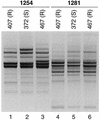Isolation and molecular characterization of nalidixic acid-resistant extraintestinal pathogenic Escherichia coli from retail chicken products
- PMID: 12821463
- PMCID: PMC161843
- DOI: 10.1128/AAC.47.7.2161-2168.2003
Isolation and molecular characterization of nalidixic acid-resistant extraintestinal pathogenic Escherichia coli from retail chicken products
Abstract
Fluoroquinolone use in poultry production may select for resistant Escherichia coli that can be transmitted to humans. To define the prevalence and virulence potential of poultry-associated, quinolone-resistant E. coli in the United States, 169 retail chicken products from the Minneapolis-St. Paul area (1999 to 2000) were screened for nalidixic acid (Nal)-resistant E. coli. Sixty-two (37%) products yielded Nal-resistant E. coli. From 55 products that yielded both Nal-resistant and susceptible E. coli, two isolates (one resistant, one susceptible) per sample were further characterized. Twenty-three (21%) of the 110 E. coli isolates (13 resistant, 10 susceptible) satisfied criteria for extraintestinal pathogenic E. coli (ExPEC), i.e., exhibited >or=2 of pap (P fimbriae), sfa/foc (S/F1C fimbriae), afa/dra (Dr binding adhesins), iutA (aerobactin receptor), and kpsMT II (group 2 capsule synthesis). Compared with other isolates, ExPEC isolates more often derived from virulence-associated E. coli phylogenetic groups B2 or D (74% versus 32%; P < 0.001) and exhibited more ExPEC-associated virulence markers (median, 10.0 versus 4.0; P < 0.001). In contrast, the Nal-resistant and -susceptible populations were indistinguishable according to all characteristics analyzed, including pulsed-field gel electrophoresis profiles. These findings indicate that Nal-resistant E. coli is prevalent in retail poultry products and that a substantial minority of such strains represent potential human pathogens. The similarity of the Nal-resistant and -susceptible populations suggests that they derive from the same source population, presumably the avian fecal flora, with Nal resistance emerging by spontaneous mutation as a result of fluoroquinolone exposure.
Figures


Similar articles
-
Extraintestinal pathogenic Escherichia coli in poultry meat products on the Finnish retail market.Acta Vet Scand. 2012 Nov 16;54(1):64. doi: 10.1186/1751-0147-54-64. Acta Vet Scand. 2012. PMID: 23158013 Free PMC article.
-
Similarity between human and chicken Escherichia coli isolates in relation to ciprofloxacin resistance status.J Infect Dis. 2006 Jul 1;194(1):71-8. doi: 10.1086/504921. Epub 2006 May 31. J Infect Dis. 2006. PMID: 16741884
-
Genetic diversity and multidrug resistance of phylogenic groups B2 and D in InPEC and ExPEC isolated from chickens in Central China.BMC Microbiol. 2022 Feb 18;22(1):60. doi: 10.1186/s12866-022-02469-2. BMC Microbiol. 2022. PMID: 35180845 Free PMC article.
-
Human and avian extraintestinal pathogenic Escherichia coli: infections, zoonotic risks, and antibiotic resistance trends.Foodborne Pathog Dis. 2013 Nov;10(11):916-32. doi: 10.1089/fpd.2013.1533. Epub 2013 Aug 20. Foodborne Pathog Dis. 2013. PMID: 23962019 Free PMC article. Review.
-
Interactions of pathogenic Escherichia coli with CEACAMs.Front Immunol. 2023 Feb 14;14:1120331. doi: 10.3389/fimmu.2023.1120331. eCollection 2023. Front Immunol. 2023. PMID: 36865539 Free PMC article. Review.
Cited by
-
Unbiased identification of risk factors for invasive Escherichia coli disease using machine learning.BMC Infect Dis. 2024 Aug 8;24(1):796. doi: 10.1186/s12879-024-09669-3. BMC Infect Dis. 2024. PMID: 39118021 Free PMC article.
-
Serotypes, virulence factors, and antimicrobial susceptibilities of vaginal and fecal isolates of Escherichia coli from giant pandas.Appl Environ Microbiol. 2013 Sep;79(17):5146-50. doi: 10.1128/AEM.01367-13. Epub 2013 Jun 21. Appl Environ Microbiol. 2013. PMID: 23793635 Free PMC article.
-
Extraintestinal pathogenic Escherichia coli in poultry meat products on the Finnish retail market.Acta Vet Scand. 2012 Nov 16;54(1):64. doi: 10.1186/1751-0147-54-64. Acta Vet Scand. 2012. PMID: 23158013 Free PMC article.
-
Differential genome contents of nontypeable Haemophilus influenzae strains from adults with chronic obstructive pulmonary disease.Infect Immun. 2006 Jun;74(6):3366-74. doi: 10.1128/IAI.01904-05. Infect Immun. 2006. PMID: 16714566 Free PMC article.
-
ECOR phylotyping and determination of virulence genes in Escherichia coli isolates from pathological conditions of broiler chickens in poultry slaughter-houses of southeast of Iran.Vet Res Forum. 2018 Summer;9(3):211-216. doi: 10.30466/vrf.2018.30827. Epub 2018 Sep 15. Vet Res Forum. 2018. PMID: 30357106 Free PMC article.
References
-
- Berg, D. E., N. S. Akopyants, and D. Kersulyte. 1994. Fingerprinting microbial genomes using the RAPD or AP-PCR method. Methods Mol. Cell. Biol. 5:13-24.
-
- Boothe, D. H., and J. W. Arnold. 2003. Resistance of bacterial isolates from poultry products to therapeutic veterinary antibiotics. J. Food Prot. 66:94-102. - PubMed
-
- Centers for Disease Control and Prevention. 1998. Standardized molecular subtyping of foodborne bacterial pathogens by pulsed-field gel electrophoresis, training course. Centers for Disease Control and Prevention, Atlanta, Ga.
-
- Cheong, H.-J., C.-W. Yoo, J.-W. Sohn, W.-J. Kim, M.-J. Kim, and S.-C. Park. 2001. Bacteremia due to quinolone-resistant Escherichia coli in a teaching hospital in South Korea. Clin. Infect. Dis. 33:48-53. - PubMed
Publication types
MeSH terms
Substances
Grants and funding
LinkOut - more resources
Full Text Sources
Medical
Research Materials

